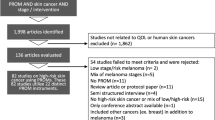Abstract
Background
Historically, skin toxicity has been assessed in prospective clinical trials using the clinician-reported National Cancer Institute Common Terminology Criteria for Adverse Events (CTCAE). The patient-reported Skindex-16 measures symptoms and perceptions of toxicity. This study was designed to compare information provided by these two measures.
Methods
Data were compiled from three placebo-controlled North Central Cancer Treatment Group studies (N06C4, N03CB, N05C4) having rash prevention as the primary objective. All used the Skindex-16 and CTCAE at baseline, weekly during treatment and during a minimum 2-week follow-up period. Statistical procedures, including Pearson correlations, were utilized to determine relationships between adverse event (AE) grades and Skindex-16 scores.
Results
Four hundred and twelve individual patients provided data (median age, 61; 134 male). Patients' Skindex-16 score results show a 0.9 overall mean (range 0–6 with 6 being worse symptoms), a 0.4 baseline mean (range, 0–4.3) and a 1.3 end-of-treatment mean (range, 0–5.9). Ninety-three, 142 and 177 patients experienced a grade 0, 1 and 2+ CTCAE skin toxicity, respectively. Baseline Skindex-16 scores had relatively low correlation with CTCAE grades. The correlation of rash grade with Skindex-16 scores ranged from r = 0.49 with the function subscale to r = 0.62 with the symptom subscale. The highest correlations of the maximum grade of any dermatological AE with the Skindex-16 were r = 0.48 for the total score and r = 0.55 for the symptom subscale.
Conclusions
The data reported support the decision to include both measures in a clinical trial to assess the patient experience, as each measure may specifically target varying symptoms and intensities.



Similar content being viewed by others
References
Hopewell JW (1990) The skin: its structure and response to ionizing radiation. Int J of Radiation Biol 57:751–773
Fu KK, Pajak TF, Trotti A et al (2000) A radiation therapy oncology group (RTOG) phase III randomized study to compare hyperfractionation and two variants of accelerated fractionation to standard fractionation radiotherapy for head and neck squamous cell carcinomas: first report of RTOG 9003. Int J Rad Oncol Biol Phys 48:7–16
Archambeau JO, Pezner R, Wasserman T (1995) Pathophysiology of irradiated skin and breast. Int J Rad Oncol Biol Phys 31:1171–1185
Herbst RS, Maddox A-M, Rothenberg ML et al (2002) Selective oral epidermal growth factor receptor tyrosine kinase inhibitor ZD1839 is generally well tolerated and has activity in non-small cell lung cancer and other solid tumors: results of a phase I trial. J Clin Oncol 20:3815–3825
Kris M, Natale RB, Herbst RS et al (2003) Efficacy of gefitinib, an inhibitor of the epidermal growth factor receptor tyrosine kinase, in symptomatic patients with non-small cell lung cancer. J Am Med Assoc 290:2149–2158
Saltz LB, Meropol NJ, Loehrer PJ et al (2004) Phase II trial of cetuximab in patients with refractory colorectal cancer that expresses the epidermal growth factor receptor. J Clin Oncol 22:1201–1208
Cancer Therapy Evaluation Program NCI. Common Terminology Criteria for Adverse events (CTCAE). http://ctep.cancer.gov/protocolDevelopment/electronic_applications/ctc.htm. Accessed 02 August 2010
Lacouture ME, Maitland ML, Sagaert S et al (2010) A proposed EGFR inhibitor dermatologic adverse event-specific grading scale from the MASCC skin toxicity group. Support Care Cancer 18:509–522
Huschka MM, Mandrekar SJ, Schaefer PL et al (2007) A pooled analysis of quality of life measures and adverse events data in north central cancer treatment group lung cancer clinical trials. Cancer 109(4):787–795
Chren MM, Lasek RJ, Sahay AP et al (2001) Measurement properties of Skindex-16: a brief quality-of-life measure for patients with skin diseases. J Cutan Med Surg 5(2):105–110
Huschka MM, Burger KN (2006) Does QOL provide the same information as toxicity data. Curr Probl Cancer 30(6):244–254
Basch E (2009) Patient-reported outcomes in drug safety evaluation. Ann Oncol 20:1905–1906
Parliament MB, Danjoux CE, Clayton T (1985) Is cancer treatment toxicity accurately reported? Int J Rad Oncol Biol Phys 11(3):603–608
Miller RC, Schwartz DJ, Sloan JA, Griffin PC, Deming RL, Anders JC, Stoffel TJ, Haselow RE, Schaefer PL, Bearden JD, Atherton PJ, Loprinzi CL, Martenson JA (2011) Mometasone furoate effect on acute skin toxicity in breast cancer patients receiving radiotherapy: a phase 3 double-blind, randomized trial from the North Central Cancer Treatment Group N06C4. Int J Radiat Oncol Biol Phys 79:1460–1466
Jatoi A, Rowland KM, Sloan JA, Gross HM, Fishkin PA, Kahanic SP, Novotny PJ, Schaefer PL, Johnson DB, Tschetter LK, Loprinzi CL (2008) Tetracycline to prevent epidermal growth factor receptor inhibitor-induced skin rashes: results of a placebo-controlled trial from the NCCTG (N03CB). Cancer 113:847–853
Jatoi A (2007) Sunshine and rash: testing the role of sunscreen to prevent epidermal growth factor receptor inhibitor-induced rash. Support Cancer Therapy 4:198–202
Neben-Wittich MA, Atherton PJ, Schwartz DJ, Sloan JA, Griffin PC, Deming RL, Anders JC, Loprinzi CL, Burger KN, Martenson JA, Miller RC (2011) Comparison of provider-assessed and patient-reported outcome measures of acute skin toxicity during a phase III trial of mometasone cream versus placebo during breast radiotherapy: the North Central Cancer Treatment Group (N06C4). Int J Radiat Oncol Biol Phys 81:397–402
National Cancer Institute, Division of Cancer Control and Population Sciences. Patient-Reported Outcomes Version of the Common Terminology Criteria for Adverse events (PRO-CTCAE). http://outcomes.cancer.gov/tools/pro-ctcae_fact_sheet.pdf. Accessed August 2, 2010
Trotti A, Colevas AD, Setser A, Basch E (2007) Patient-reported outcomes and the evolution of adverse event reporting in oncology. J Clin Oncol 25(32):5121–5127
Conflict of interest
There are no conflicts of interest to disclose for any of the authors.
Author information
Authors and Affiliations
Corresponding author
Additional information
This work was funded by the National Cancer Institution Community Clinical Oncology Program (CCOP) grant CA37404 and the North Central Cancer Treatment Group (NCCTG) grant (CA25224).
Rights and permissions
About this article
Cite this article
Atherton, P.J., Burger, K.N., Loprinzi, C.L. et al. Using the Skindex-16 and Common Terminology Criteria for Adverse Events to assess rash symptoms: results of a pooled-analysis (N0993). Support Care Cancer 20, 1729–1735 (2012). https://doi.org/10.1007/s00520-011-1266-x
Received:
Accepted:
Published:
Issue Date:
DOI: https://doi.org/10.1007/s00520-011-1266-x




